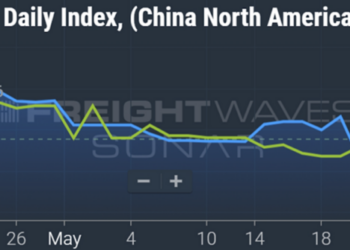A November survey of supply chain managers fell back into contraction territory with transportation metrics partly to blame.
The Logistics Managers’ Index (LMI) produced a reading of 49.4 during the month, which was 7.1 percentage points worse than October and followed three consecutive months of expansion. The data is compiled in a diffusion index where a reading above 50 indicates expansion while one below 50 signals contraction.
The index’s transportation metrics remained uninspiring from a carriers’ perspective during November. Capacity (61.8) increased 5.2 points, utilization (50) fell 10.7 points and pricing (44.2) remained on the decline.
Transportation capacity remained “prevalent across the supply chain” and has been on the rise since April 2022, according to the Tuesday report. When asked about transportation capacity one year from now, respondents returned a reading of 48.2, with downstream participants like retailers expecting a faster rate of contraction (43.8).
While off just slightly from October, transportation prices remained in contraction territory and the rate of decline worsened for the first time in six months. However, the responses were less-bad (47) in the last two weeks of the month “as last-mile deliveries [of] holiday goods picked up.”
“It is interesting that Transportation Prices, which have been the lowest metric all year and are often the canary in the coalmine for the overall logistics industry is the metric that had the smallest drop during November’s swoon,” the report said.
The 12-month forward expectation for transportation prices was solidly in growth mode at 63.8.
Chart: (SONAR: OTRI.USA). A proxy for truck capacity, the Outbound Tender Reject Index, shows the number of loads being rejected by carriers. Carriers are currently rejecting less than 4% of all loads tendered under contract. To learn more about FreightWaves SONAR, click here.
Chart: (SONAR: NTIL.USA). The National Truckload Index (linehaul only – NTIL) is based on an average of booked spot dry van loads from 250,000 lanes. The NTIL is a seven-day moving average of linehaul spot rates excluding fuel. Spot rates are currently 8% lower y/y.
Part of the backslide in the overall LMI wasn’t really bad news as inventory levels (44.3) experienced a 9.1-point sequential drop as holiday sales ramped during the month. Downstream respondents returned a future expectation of 41.5 as their merchandise has moved off the shelves but may not be immediately restocked, whereas upstream wholesalers plan to more aggressively build inventories, returning a future expectation of 54.7.
“Essentially, November’s decline seems to have come because firms are selling off inventories quickly,” the report said. “The previous large decline from April 2022 happened because firms had too much inventory and couldn’t sell any of it. Both of these scenarios led to large drops in the overall LMI, but this more recent drop is significantly less concerning.”
Warehousing capacity (60.6) continued to expand at a rate that was 3.6 points higher sequentially and nearly 14 points higher than the year-ago level. Warehousing utilization (52.9) continued to increase but at a rate that was 14 points lower than in October. Contraction was noted at the wholesale level of the supply chain while downstream respondents returned a utilization reading of 59.8.
Even with new space coming online, warehouse prices (64.2) remained on the rise, albeit 6.5 points lower than in October. The growth rates have slowed but prices continue to increase after numerous months of growth, including the exorbitant growth rates (90-plus) logged during the pandemic. Respondents returned a 12-month expectation of 65.3 for warehouse prices, indicating an expectation that rents will be growing at a similar clip one year from now.
The LMI is a collaboration among Arizona State University, Colorado State University, Florida Atlantic University, Rutgers University and the University of Nevada, Reno, conducted in conjunction with the Council of Supply Chain Management Professionals.
More FreightWaves articles by Todd Maiden
XPO’s November shipment increase needed to fill 28 new terminals
First wave of Yellow terminals will go for $1.9B; sale process ongoing
Saia holds on to Yellow’s freight
The post Transportation capacity grows faster in November, prices continue to slide appeared first on FreightWaves.













